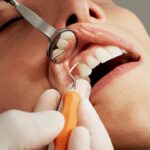A Maryland bridge, also known as a resin-bonded bridge, is a dental restoration used to replace a missing tooth. Unlike traditional bridges, Maryland bridges do not require the alteration of adjacent teeth for support. Instead, they rely on a metal or porcelain framework that is bonded to the back of the adjacent teeth. The replacement tooth, typically made of porcelain, is then attached to the framework, creating a seamless and natural-looking restoration.
Maryland bridges are a popular choice for patients who are missing a single tooth and want a minimally invasive solution. They are known for their ability to blend in with the natural teeth, providing a functional and aesthetically pleasing result. Maryland bridges are also relatively quick and easy to install, making them a convenient option for many patients.
Key Takeaways
- A Maryland Bridge Dental is a type of dental bridge that is used to replace a missing tooth by bonding a false tooth to the adjacent natural teeth.
- The benefits of Maryland Bridge Dental include preserving the natural structure of adjacent teeth, easy maintenance, and a natural-looking appearance.
- Maryland Bridge Dental revolutionizes smiles by providing a non-invasive and cost-effective solution for replacing missing teeth and improving overall dental aesthetics.
- The process of getting a Maryland Bridge Dental involves a consultation with a dentist, preparation of the adjacent teeth, and bonding of the bridge in place.
- Good candidates for Maryland Bridge Dental are individuals with one or more missing teeth who have healthy adjacent teeth and good oral hygiene habits.
- When comparing Maryland Bridge Dental with other dental solutions, it is important to consider factors such as durability, cost, and impact on surrounding teeth.
- The future of Maryland Bridge Dental technology looks promising, with advancements in materials and techniques leading to even more natural-looking and long-lasting results.
The Benefits of Maryland Bridge Dental
One of the main benefits of Maryland bridge dental is its conservative approach to tooth replacement. Unlike traditional bridges, Maryland bridges do not require the alteration of adjacent teeth, preserving their natural structure and integrity. This means that patients can maintain the health and strength of their existing teeth while still addressing the issue of a missing tooth.
Another benefit of Maryland bridge dental is its natural appearance. The replacement tooth is custom-made to match the color, shape, and size of the surrounding teeth, creating a seamless and natural-looking result. This can help patients feel more confident in their smile and avoid the self-consciousness that often comes with missing teeth.
Additionally, Maryland bridges are relatively quick and easy to install compared to other dental restorations. The process typically involves minimal discomfort and can be completed in just a few visits to the dentist. This makes Maryland bridge dental a convenient option for patients who want to restore their smile without a lengthy or complicated treatment process.
How Maryland Bridge Dental Revolutionizes Smiles
Maryland bridge dental has revolutionized smiles by providing a minimally invasive and natural-looking solution for missing teeth. In the past, traditional bridges or dental implants were often the go-to options for replacing missing teeth. However, these solutions often required the alteration of adjacent teeth or invasive surgical procedures.
With Maryland bridge dental, patients can now enjoy a conservative and aesthetically pleasing alternative. The ability to preserve the natural structure of adjacent teeth while still achieving a seamless and functional restoration has transformed the way missing teeth are addressed in dentistry. Patients no longer have to compromise the health of their existing teeth or undergo extensive procedures to restore their smile.
Furthermore, Maryland bridge dental has revolutionized smiles by offering a quick and convenient treatment option. Patients can achieve a natural-looking and durable restoration in just a few visits to the dentist, without the need for lengthy or complicated procedures. This has made it easier for individuals to address their missing teeth and regain confidence in their smile without disrupting their daily lives.
The Process of Getting a Maryland Bridge Dental
| Step | Description |
|---|---|
| 1 | Consultation with a dentist to determine eligibility for a Maryland bridge |
| 2 | Preparation of the adjacent teeth for the bridge |
| 3 | Impressions of the teeth to create the bridge |
| 4 | Temporary bridge placement while the permanent bridge is being made |
| 5 | Placement of the permanent Maryland bridge |
| 6 | Follow-up appointments for adjustments and maintenance |
The process of getting a Maryland bridge dental typically begins with a consultation with a dentist. During this initial visit, the dentist will assess the patient’s oral health and discuss their treatment goals. If Maryland bridge dental is deemed suitable for the patient, the dentist will then take impressions of the teeth to create a custom-made replacement tooth.
Once the replacement tooth is ready, the dentist will prepare the adjacent teeth by etching the surface and applying a bonding agent. The metal or porcelain framework of the Maryland bridge is then bonded to the back of the adjacent teeth, and the replacement tooth is attached to complete the restoration. The dentist will ensure that the fit and appearance of the Maryland bridge are optimal before finalizing the treatment.
After the Maryland bridge is installed, patients will be advised on how to care for their restoration and maintain good oral hygiene. Regular check-ups with the dentist will also be recommended to ensure that the Maryland bridge remains in good condition and continues to provide a functional and natural-looking result.
Who is a Good Candidate for Maryland Bridge Dental?
Good candidates for Maryland bridge dental are typically individuals who are missing a single tooth and have healthy adjacent teeth. Since Maryland bridges rely on the support of adjacent teeth, it is important that these teeth are strong and free from decay or damage. Additionally, candidates should have good overall oral health and be committed to maintaining proper oral hygiene.
Patients who are looking for a conservative and natural-looking solution for their missing tooth may also be good candidates for Maryland bridge dental. The ability to preserve the natural structure of adjacent teeth while still achieving a seamless restoration makes Maryland bridges an attractive option for many individuals.
It is important for candidates to consult with a dentist to determine if Maryland bridge dental is suitable for their specific needs. The dentist will assess their oral health, discuss their treatment goals, and recommend the most appropriate solution for replacing their missing tooth.
Comparing Maryland Bridge Dental with Other Dental Solutions

When comparing Maryland bridge dental with other dental solutions, there are several factors to consider. Traditional bridges, for example, require the alteration of adjacent teeth for support, while Maryland bridges do not. This makes Maryland bridges a more conservative option that preserves the natural structure of adjacent teeth.
Dental implants are another popular solution for replacing missing teeth. While implants offer a durable and long-lasting restoration, they require invasive surgical procedures and may not be suitable for all patients. In contrast, Maryland bridges provide a quicker and less invasive alternative that still delivers a natural-looking result.
Another consideration when comparing dental solutions is cost. Maryland bridges are often more affordable than dental implants, making them a more accessible option for many patients. The convenience and efficiency of Maryland bridge dental also make it an attractive choice for individuals who want to restore their smile without a lengthy or complicated treatment process.
The Future of Maryland Bridge Dental Technology
The future of Maryland bridge dental technology looks promising as advancements continue to improve the durability, aesthetics, and overall performance of these restorations. With ongoing research and development, new materials and techniques are being explored to enhance the quality and longevity of Maryland bridges.
One area of focus in the future of Maryland bridge dental technology is the development of stronger and more resilient materials for the framework and replacement tooth. This can help improve the durability of Maryland bridges and ensure that they can withstand the demands of daily use.
Advancements in digital imaging and 3D printing technology are also expected to play a role in the future of Maryland bridge dental. These technologies can streamline the process of creating custom-made replacement teeth, resulting in more precise and accurate restorations that closely match the natural teeth.
Overall, the future of Maryland bridge dental technology holds great potential for further improving the patient experience and outcomes. As technology continues to evolve, patients can expect even more natural-looking, durable, and convenient solutions for replacing missing teeth with Maryland bridges.
If you’re considering getting a Maryland bridge dental procedure, you may also be interested in learning about natural ways to improve your oral health. Check out this article on naturalvitalspark.com for tips on maintaining healthy teeth and gums through natural remedies and lifestyle changes. Taking care of your oral health can help ensure the success and longevity of your dental bridge.
FAQs
What is a Maryland bridge dental?
A Maryland bridge dental is a type of dental bridge that is used to replace a missing tooth. It consists of a false tooth (pontic) that is held in place by a metal or porcelain framework that is bonded to the back of the adjacent teeth.
How is a Maryland bridge dental different from other types of dental bridges?
A Maryland bridge dental is different from traditional dental bridges in that it does not require the adjacent teeth to be filed down in order to support the bridge. Instead, the framework is bonded to the back of the adjacent teeth, making it a more conservative option.
What are the advantages of a Maryland bridge dental?
The main advantage of a Maryland bridge dental is that it is a more conservative option compared to traditional bridges, as it does not require the adjacent teeth to be filed down. It is also a quicker and less invasive procedure, and can be a good option for patients who want to preserve the structure of their natural teeth.
What are the disadvantages of a Maryland bridge dental?
One disadvantage of a Maryland bridge dental is that it may not be as strong or durable as traditional bridges, especially for replacing a missing molar. The metal or porcelain framework may also be visible from the back of the teeth, which can affect the aesthetics of the smile.
How long does a Maryland bridge dental last?
The lifespan of a Maryland bridge dental can vary depending on factors such as oral hygiene, bite forces, and the materials used. On average, a Maryland bridge dental can last between 5-10 years with proper care and maintenance. Regular dental check-ups and good oral hygiene practices can help prolong the lifespan of the bridge.


